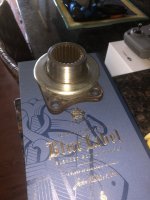wolfpak110
Member
200TDI 93 D90.
Hi all, I have a front diff pinion seal that keeps leaking. I have replaced this seal twice already, recently, and used the LR tool and a LR seal.... So I assume the seal was inserted correctly and at the appropriate depth. I have checked the breather and its line- all clear. The flange appears to be in great shape too, no nicks or rust.
What could be making this leak again? Where else should I look for the culprit of this leak?
Thanks in advance!
Hi all, I have a front diff pinion seal that keeps leaking. I have replaced this seal twice already, recently, and used the LR tool and a LR seal.... So I assume the seal was inserted correctly and at the appropriate depth. I have checked the breather and its line- all clear. The flange appears to be in great shape too, no nicks or rust.
What could be making this leak again? Where else should I look for the culprit of this leak?
Thanks in advance!
